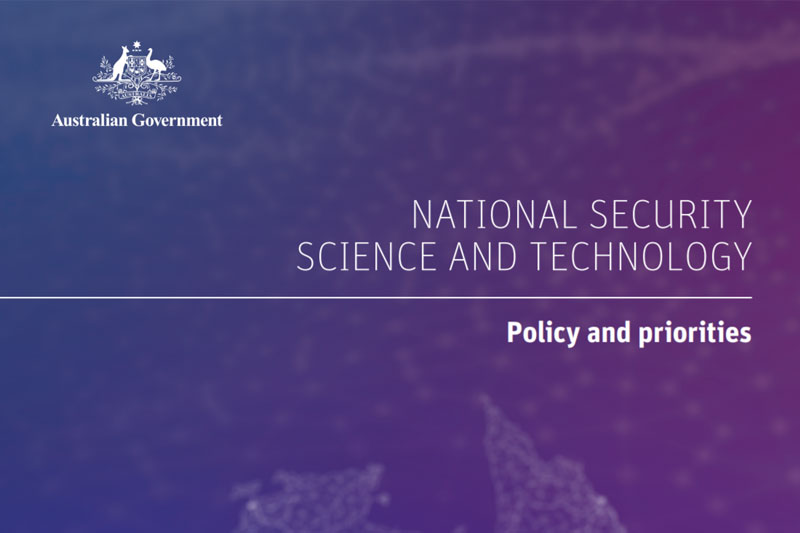
On May 1, the Australian Government released
its new National security science and technology policy agenda aimed at
strengthening Australia’s national security.
Defence Science and Technology (DST) coordinates the
government’s science and technology program for national security.
This policy delivers on commitments in the 2016
Defence White Paper. The science and technology policy and priorities
were developed in consultation with the various national security agencies
under a high-level inter-departmental steering committee.
The paper outlines the national security science and
technology priorities, governance arrangements and engagement mechanisms as
they exist now, these will need to co-evolve as arrangements are re-defined under
the new national security architecture, with the establishment of the Home
Affairs portfolio and the Office of National Intelligence.
A National Security Science and Technology Interdepartmental
Committee (NSST IDC) established in March 2017 will review and endorse national
security science and technology policies and priorities and promote
cross-agency collaboration on science and technology, which will deliver
efficiencies and reduce duplication. NSSTC will assist national security
agencies to elucidate their science and technology requirements, and then
foster collaboration with the innovation community to address these
requirements.
Currently, many of the investments in science and technology
that are being made across the national security community are by individual
agencies with individual suppliers. NSSTC will play the role of raising
collective awareness across the agencies of these investments, to potentially
enable a more collective and efficient approach, and facilitate the pooling of
resources across agencies who share common capability goals and requirements.
The agenda is focused on new
science and technology policy priorities for national security. These include:
- Cyber security: To anticipate vulnerabilities, strengthen cyber
systems and critical infrastructure, and enhance national capacity to respond
to and recover from cyber-attack, investment in science and technology is
crucial to ensure that the government remain alert and responsive to evolving
threats. Many of the agencies consulted noted the need for research to support
the continued and growing requirement for scalable high assurance, resilient
computing for multilevel security, secure gateways allowing agencies to have
connectivity between the internet facing elements of their role and the
sensitive information held within the agencies, as well as secure cloud based
storage. S - Intelligence: Rapidly changing and advancing technologies are
transforming how information is collected, integrated and exploited. Many of
the agencies noted the need for greater automation with some highlighting that
this should occur as close to the point of collection as possible. Further to
this, the systems and services enabling intelligence exploitation need to be
trusted by the user, with high integrity and reliability, underpinned by a
quality assurance framework. The policy document notes that these efforts would
need to operate within current policy boundaries, ensuring that the privacy of
Australians is met. - Border security and identity management: The key theme to emerge in
this priority area was the capability to identify objects, including explosives,
chemical, biological or radiological agents, disease, drugs and other
contraband. Many of the agencies consulted highlighted the continued need for
science and technology to support development in biometrics broadly. This
includes the need for the development of methods to enable both field
deployable and scalable stand-off biometric capabilities. Challenges including
the ability to compare biometric data from different quality data sets, as well
as the need for secure real time linkages to internet facing capabilities. - Investigative support and forensic science: The ability to use
information to deliver forensic and investigative support to our national
security and law enforcement agencies is essential in ensuring effective
prosecutions or the disruption of terrorist and trans-national criminal
activities. New technologies are needed to enable the ‘in-field’ screening and
analysis of items to provide timely, accurate, scientific information to
support investigations. Research programs advancing the state of the art in
traditional forensic science and technology, including that related to
fingerprints, genetic material, illicit drugs, explosives and other trace and
physical evidence are ongoing in academic, industry and government facilities.
With the increase in the use of digital technologies some agencies identified a
requirement for more advanced digital forensic tools to support investigations. - Preparedness to prevent and respond to incidents: This priority
area covers the broadest range of topics. Important aspects within this
priority include the enduring ability to prepare for, protect against, prevent
and respond to chemical, biological, radiological, nuclear and explosive events
with an emphasis on remote means. Science and technology to support activities
to counter violent extremism was highlighted as a need by some agencies.
Methods and techniques to identify a threat from and to counter uncrewed aerial
systems/vehicles is a common requirement, as well as using these uncrewed
devices to provide tactical capabilities such as surveillance and
communications - Technology foresighting: Technology
foresighting will monitor global technology trends and developments in emerging
science to forecast future challenges and opportunities. DST has a cell which
maintains a science and technology horizon scanning capability in partnership
with international agencies, to provides a broad perspective on potential
game-changing threats and opportunities. Technologies which are identified as
having potential for disruptive impact are then examined in more depth.
Emerging and Disruptive Technologies Assessment Symposia (EDTAS) are now a
biannual event co-hosted by DST, with the focus on a new ‘disruptive’ or ‘game
changing’ technology at each event. Recent symposia have looked at the themes
of Trusted Autonomous Systems and Digital Disruption. Future symposia will
explore themes of advanced sensors, materials science/advanced manufacturing
and quantum technologies.
Minister for Defence Industry, the Hon Christopher Pyne MP, said,
“Australia needs to remain at the forefront of science and innovation so we can
meet any new and emerging threats to our security. This is why the Government
has released this new agenda, which replaces a decade old policy.
“We must work seamlessly across government and in
collaboration with our industry and university partners to develop the best
capabilities for protecting Australia against threats to our national security.
“This policy puts us in a strong position to harness the
expertise and resources required to address national security challenges now
and into the future,” he added.
The Chief Defence Scientist, Dr Alex Zelinsky, will address
the policy highlights at the Science and Technology Innovation for Civil and
National Security conference at CIVSEC 2018 in Melbourne.
Access the document here.
















